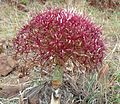Boophone
| Boophone | |
|---|---|

| |
| Inflorescence of Boophone disticha | |
| Scientific classification | |
| Kingdom: | Plantae |
| Clade: | Tracheophytes |
| Clade: | Angiosperms |
| Clade: | Monocots |
| Order: | Asparagales |
| Family: | Amaryllidaceae |
| Subfamily: | Amaryllidoideae |
| Tribe: | Amaryllideae |
| Subtribe: | Boophoninae |
| Genus: | Boophone Herb.[1][full citation needed] |
| Species | |
| Synonyms | |
| |
Boophone is a small
Taxonomy
Boophone is the single genus in subtribe Boophoninae, in the Amaryllideae tribe.
Phylogeny
Boophoninae are placed within Amaryllideae as follows, based on their phylogenetic relationship:[citation needed]
| Tribe Amaryllideae |
| ||||||||||||||||||
Species
The list of Boophone species, with their complete
| Flowers | Plant | Scientific name | Distribution |
|---|---|---|---|
 |
 |
L.f.) [5][full citation needed ] |
From Sudan to South Africa |
 |
 |
Boophone haemanthoides Leight.[6] | From Western Cape Province
|
Etymology
William Herbert wrote the name of this genus with three different orthographies: "Boophane" in 1821; "Buphane" and "Buphone" in 1825. This final spelling was corrected to "Boophone" in 1839 by Milne-Redhead. The name was derived from the Greek bous (an ox) and phone (death), due to its toxic nature to cattle. A proposal was published in 2001 to conserve the name "Boophone" and to take the earlier ones as synonyms.[7] This proposal was accepted in 2002.[8]
Associated insects
Larvae of the moth genera Brithys and Diaphone use Boophone as a food plant.
Traditional medicine
Boophone disticha is used in South African traditional medicine by the Zulu people to induce hallucinations for divinatory purposes, and also for various mental illnesses.[9] Its use, however, is limited by injuries that result from the plant's toxicity.[10] They have also been used as ingredients in traditional arrow poisons, and medicinal dressings for skin lesions.[11]
Chemistry
A variety of alkaloids with affinity for the serotonin transporter have been isolated from Boophone disticha.[12][13]
References
- ^ Appendix: 18 (1821).
- ^ Stevens, P.F. "Angiosperm Phylogeny Website: Asparagales: Amaryllidoideae".
- ^ Vigneron, P. (2000–2006). "Boophone". Amaryllidaceae organization. Archived from the original on 2009-07-16. Retrieved 2009-05-31.
- ^ Royal Botanical Gardens, Kew. World Checklist of Monocotyledons: Boophone . Accessed May 16, 2009.
- Herb.Bot. Mag. 52: t. 2578 (1825)
- ^ Leighton, Frances Margaret. Journal of South African Botany 13: 59. 1947. [full citation needed]
- JSTOR 1223904.
- ^ Richard K. Brummitt. 2002. Report of the Committee for Spermatophyta: 53. Taxon, Vol. 51, No. 4 (Nov., 2002), pp. 795–799.
- PMID 18775771.
- S2CID 40983799.
- ^ "Amaryllidaceae". succulent-plant.com. Retrieved 2018-02-07.
- PMID 15814274.
- .
